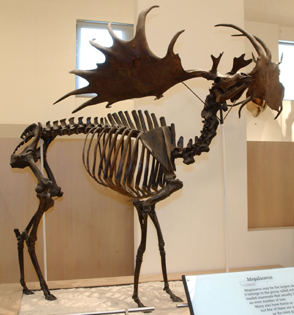 The now-extinct
Irish elk, which lived at the same time as saber-toothed tigers and mastodons,
generally stood over 10 feet tall, with antlers that may have weighed more than
100 pounds. How these animals became extinct is not known. Some scientists have
argued that the huge beasts were wiped out by human hunters, who had been present
in Europe at the same time. Previous dates from European Irish elk fossils indicated
that they disappeared once their ecosystems were wiped out by the most recent
ice age. But new dates show that the ancient deer lived thousands of years longer
than previously thought — another blow for the timing of extinctions of
large mammals at the end of the last ice age.
The now-extinct
Irish elk, which lived at the same time as saber-toothed tigers and mastodons,
generally stood over 10 feet tall, with antlers that may have weighed more than
100 pounds. How these animals became extinct is not known. Some scientists have
argued that the huge beasts were wiped out by human hunters, who had been present
in Europe at the same time. Previous dates from European Irish elk fossils indicated
that they disappeared once their ecosystems were wiped out by the most recent
ice age. But new dates show that the ancient deer lived thousands of years longer
than previously thought — another blow for the timing of extinctions of
large mammals at the end of the last ice age.Irish elk, a relative of modern-day deer that stood over 10 feet tall, like this specimen at the American Museum of Natural History in New York City, survived more than 3,000 years past their presumed extinction date, according to new fossil evidence. Courtesy of the AMNH.
Even though the Irish elk had disappeared from Britain by 20,000 years ago, they returned during the Pleistocene, around 12,000 years ago with the spread of woodland and scrub vegetation, perhaps from forests farther to the east, where more recent specimens have been found. Their absence in the western and central European fossil record roughly matches the last glacial maximum, when ice sheets were at their largest extent in the region, and tundra and steppe ecosystems dominated the landscape. They disappeared from the western European fossil record for good by about 10,000 years ago. The new radiocarbon dates for Irish elk fossils, published in the Oct. 7 Nature, show they lived in eastern Europe until at least 7,700 years ago — 3,000 years later than when the animals were presumed extinct — in slices of forest that remained in the Ural Mountains after the onset of the last big ice age.
Those forests survived between tundra and steppe that would have been insufficient for the Irish elk’s nutritional needs. To grow their antlers quickly and at just the right time for their mating season, male elk would have needed diets rich in calcium and phosphorous, gleaned over many acres of forests of birch, tall willow and other trees. The forests also needed to be well-spaced for the males to navigate easily with their huge headdresses.
Despite finding refuge in the Urals for thousands of years after they disappeared from the rest of Europe, the surviving populations probably could not recolonize their former territories after their final shift eastward, says Anthony Stuart of University College London, lead author of the research. “The animals are shifted about very drastically by the changes in climate,” Stuart says. “Whether climate change and the environmental changes that come with it [are] sufficient to account for that extinction is another matter.”
Tony Barnosky, a paleobiologist at the Museum of Vertebrate Zoology at the University of California at Berkeley and lead author of a review of the Pleistocene extinctions debate in the Oct. 1 Science, says that “most animals have limits to their geographic ranges — the presence of another species, certain types of topography they can’t cross, a certain climate zone.” He says that humans may have been “part of the mix” preventing Irish elk populations from leaving their refuge in the Urals. But he says it is important to keep in mind that in this case, the extinction events, usually regarded as sudden, lasted at least 3,000 years.
The debate over whether these extinctions are from climate and environmental changes or human hunting will not be settled by these new results, says Ross MacPhee of the American Museum of Natural History in New York City. The new dates are “one of several new pieces” that give “a significant wrinkle to the picture,” he says.
Improved radiocarbon dating has shown that several creatures previously thought to have died out around 10,000 to 11,000 years ago actually were around much longer, MacPhee says. “We were thinking our dating samples were adequate and they weren’t,” he says. “All bets concerning cause are off.”
“Previous to this, we had only a few fossils from a few places or many from one place,” such as the Irish elk clustered in Ireland, says John Pastor, a moose ecologist at the University of Minnesota at Duluth, who wrote an accompanying comment to Stuart and co-workers’ report in Nature. Lack of food or human predation may have been factors, but the whole picture is more complex, Pastor says. “We have to rethink how these animals went extinct, and it’s not so simple as ‘they all died out the same time everywhere.’”

